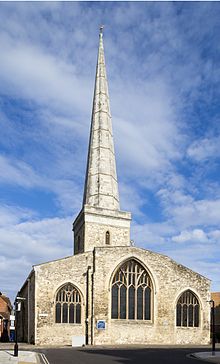St. Michael's Church, Southampton
| St. Michael's Church, Southampton | |
|---|---|
| Church of St. Michael | |

The Parish Church of St Michael, Southampton
|
|
| 50°53′59″N 1°24′19″W / 50.89959°N 1.40515°WCoordinates: 50°53′59″N 1°24′19″W / 50.89959°N 1.40515°W | |
| Location | Southampton, Hampshire |
| Country | England |
| Denomination | Anglican |
| Website | Parish of Southampton (City Centre) |
| History | |
| Founded | 1070 |
| Dedication | St. Michael |
| Architecture | |
| Status | Parish church |
| Functional status | Active |
| Heritage designation | Listed building – Grade I |
| Architectural type | Church |
| Style | Norman |
| Completed | Last major re-building 1872 |
| Specifications | |
| Spire height | 165 ft 0 in (50.29 m) |
| Materials | Ashlar |
| Administration | |
| Parish | Southampton (City Centre) |
| Deanery | Southampton |
| Archdeaconry | Bournemouth |
| Diocese | Winchester |
| Province | Canterbury |
| Clergy | |
| Bishop(s) | Bishop of Southampton |
| Rector | Revd Dr Julian Davies |
| Vicar(s) | Fr Steve Hall & Revd Tim Daykin |
| Curate(s) | Revd Phil Hand |
St. Michael's Church is the oldest building still in use in the city of Southampton, England, having been founded in 1070, and is the only church still active of the five originally in the medieval walled town. The church is a Grade I Listed building.
The church occupies the east side of St. Michael's Square off Bugle Street in the heart of the Old Town, opposite the Tudor House Museum. In Medieval times, the Fish Market (now the Tudor Merchant's Hall adjoining the Westgate) was situated in St. Michael's Square.
Following the Norman Conquest of England, the town of Southampton was moved west from the original Saxon settlement of Hamwic, around the older St. Mary's Church, to higher ground closer to the River Test. Archaeological evidence has dated the foundation of the church at 1070 and the church was dedicated to St. Michael, patron saint of Normandy. The original church was built on a cruciform plan; the earliest parts of the present Church are the lower storeys of the central tower.
The first documentary evidence of the existence of St. Michael's was in 1160 when Henry II granted the Chapels of St. Michael, Holyrood, St. Lawrence and All Saints to the monks of St. Denys, who retained the patronage until the Dissolution in 1537 when St. Michael's passed to the Crown.
As the town prospered during the Middle Ages, becoming one of the most important ports in England, so did St. Michael's, being at the heart of the thriving medieval town. St. Michael's was enlarged with chapels being added to both sides of the Chancel in the 13th century. During the French raids on the town in October 1338, the church was badly damaged by fire, with the wooden buildings attached to it being completely destroyed. The French raids in the Hundred Years' War and the Black Death damaged the prosperity of the town, and it was not until the end of the 14th century that prosperity returned, with the resumption of the wine trade being evidenced by the large number of wine vaults under the old town streets.
...
Wikipedia

